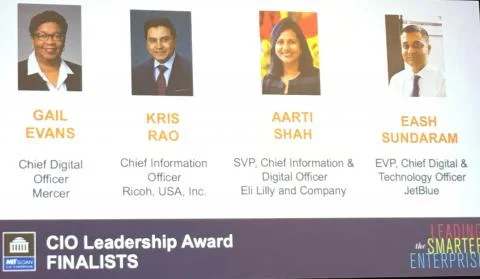If you want a picture of what today’s successful CIOs look like, take a look around the MIT Sloan CIO Symposium. As I talked with CIOs at the event last week, it struck me that the ones getting the most done right now have one quality in common: Extraordinary people skills.
That was not the case in 2006, when I started reporting on the CIO community. Then, success was all about your ability to manage big, thorny implementations, and perhaps to spot the next big thing early. Brilliant egotists were tolerated. Today, success is all about your ability to work with people – on cross-functional teams, in agile ways, doing fast experiments, without burning out talent.
So you may have a successful AI pilot under your belt. You may have data analysis skills that other people envy. But if you can’t inspire people at times of great change – like when that AI system leads to a complete rethink of how several departments are organized – you may hit a career wall.
When it comes to people skills and other must-haves, you can learn much from listening to CIOs who’ve walked through a few more fires than you have. Consider this wisdom shared at a panel discussion with the four finalists (pictured above) for the MIT Sloan CIO Symposium Leadership Award (Eash Sundaram, EVP, Chief Digital and Technology Officer, JetBlue, was the award winner):
1. CIOs think the role continues to change – for the better
George Westerman, principal research scientist with the MIT Sloan Initiative on the Digital Economy, polled the panelists and discussion audience with this question: In ten years, will the CIO role be much better than the CIO role of today?
Here’s what they said:
- Much better: 48 percent
- Somewhat better: 26 percent
- About the same: 14 percent
- Somewhat worse: 9 percent
- Much worse: 3 percent
Eash Sundaram, EVP, chief digital and technology officer, JetBlue, summed it up this way: “The CIO of the future will be the ‘chief influence officer.’ How your organization influences customer experiences will be built on technology.”
Westerman noted that it’s becoming more common for CIOs to also be CDOs – and three of this year’s four finalists for the leadership award have “digital” in their title.
As Sundaram said, who better than the CIO to lead how customer experience could be improved using digital technologies?
[ Read also: 5 takeaways for IT leaders from the MIT Sloan CIO Symposium and 7 hard truths about digital transformation. ]
2. Vocabulary matters
Gail Evans, previously CIO at consulting company Mercer, now serves as CDO. She uses words like “co-creating” to describe how Mercer staffers are using new technologies, learning new skills, and working differently – for instance, with a new AI tool they call Warren, which can serve up information about a client before a meeting.
What does it take to make the transition to being a digital leader, shaping the future of the business? Evans cited three keys: Know the business, know the technology (table stakes), and lead conversations about value.
“You have to be a leader – you have to humble yourself and know how to laugh at yourself sometimes,” she said, adding that some people in your organization like the IT order-takers of old – it’s up to you to build the relationship.
“At the end of the day,” Evans said, “the company has to make money. How do you serve your clients; are you serving the right pain points for your clients? You can call me XYZ – it doesn’t matter.” This is the kind of CIO turned CDO who reports to the CEO. (In December 2018, we named Evans one of 20 CIOs to follow on Twitter for digital transformation wisdom.)
3. Reconsider your old ideas about talent
Attracting and retaining IT talent continues to be a top worry for CIOs. Salaries, perks, and remote working options can all play a part. But are the most creative IT leaders starting to think differently about hiring? Listen to what JetBlue’s Sundaram says: “Tech is no longer looked at as a skillset. It’s a toolkit.”
He says one of the best data scientists he’s worked with recently is an English literature major. Take that in for a minute. Now ask yourself: Are you talking about finding curious learners – or actually hiring them on your IT team?
What are the major skill gaps in IT teams? “Skills is undefinable now,” Sundaram says. “It changes by the day, month, hour. The best advice is to be a learning person and a learning company…and be prepared for the change.”
Aarti Shah, SVP, chief information and digital officer, Eli Lilly and Company, said her organization has focused on raising the “digital quotient and analytics quotient” across the board. E-learning helps here, she said. At the executive level, she brings in outsiders to look at where the industry is going in 10 years.
Should everyone in the company know how to program? “No,” says Evans. “You can’t teach having fire in the gut. What we need is that passion and fire in the gut to get something done. I thrive on it.”
4. What’s the best IT leadership advice you ever received?
“Trust and cross the bridge: Don’t hesitate to take that new assignment.” – Shah
“It is not about telling, it’s about selling. The job of a technologist is to reach across the aisle and sell an idea to colleagues.” – Kris Rao, CIO, Ricoh USA
“As leaders, you have to lead from the back on good days. Lead from the front during difficult ones.” – Sundaram
5. Your advice to aspiring CIOs
“Take one step at a time. Learn every day.” – Sundaram
“Be a student of leadership. Learn your business.” – Shah
“Learn psychology.” – Rao
“Have fun. Be patient. Be a student.” – Evans
[ How strong are your soft skills? Read also: Emotional intelligence test: 5 self-evaluation tools for leaders. ]






